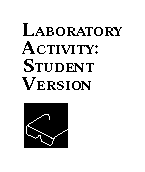

Activity 3: Analysis of Milk
Introduction
Milk is the complete food. It contains all of the major food groups required to meet the body's needs. You will analyze milk to determine the relative amounts of water and the three food groups - fats. proteins, and carbohydrates - contained in a typical milk sample.
Purpose
To determine the composition of milk.
Safety
- Wear protective goggles throughout the laboratory activity.
- The extraction solvent fumes are volatile and harmful. Use under a fume hood or in a well ventilated room.
- Do not use mouth suction when filling pipets. Always use a pipet bulb. Your teacher will instruct you in its use.
- When heating liquids, add boiling chips to avoid "bumping".
- Dispose of excess liquids and solids as directed by your teacher.
- Carefully read the laboratory activity before coming to the laboratory. Think about what you are going to do and plan ahead.
Procedure
Day 1
Part 1: Extracting and determining the percentage of Milk Fat in Milk
- Weigh an empty 250-mL Erlenmeyer flask to +/- 1g. Record mass in data table.
- Using a graduated cylinder, add 100 mL milk to the flask and weigh again. Record mass in data table.
- Using a second 100-mL graduated cylinder, add 100-mL nonpolar solvent (to be specified by your teacher) to the milk sample. Stopper the flask tightly.
- Mix the flask contents for about 1 min by gently but repeatedly turning the flask over. Avoid vigorous shaking to prevent formation of small fat globules. The small globules increase the fatty material's surface area and trap nonfat materials in the fatty layer.
- After mixing, allow the mixture to settle until the two layers are separated. The top layer is the nonpolar solvent layer; it contains the fat-soluble components of milk. The bottom layer is the aqueous layer; it contains the water-soluble components of milk.
- Weigh a 250-mL beaker to +/- 1g and record its mass in the data table.
- Using a pipet, remove the aqueous (bottom) layer by successively withdrawing the liquid and transferring it into the weighed 250-mL beaker. The last portion can be withdrawn by having your partner tip the flask about 45 degrees to concentrate the remaining volume of water-soluble layer in the bottom of the flask and then carefully withdrawing as much as you can without mixing it with the nonpolar solvent layer.
- Weigh the 250-mL beaker containing the aqueous layer and record the mass.
- Using these data, calculate the percent milk fat in the original milk sample. Save bottom layer for use in Part 2; discard waste materials as directed by your teacher.
Continue



